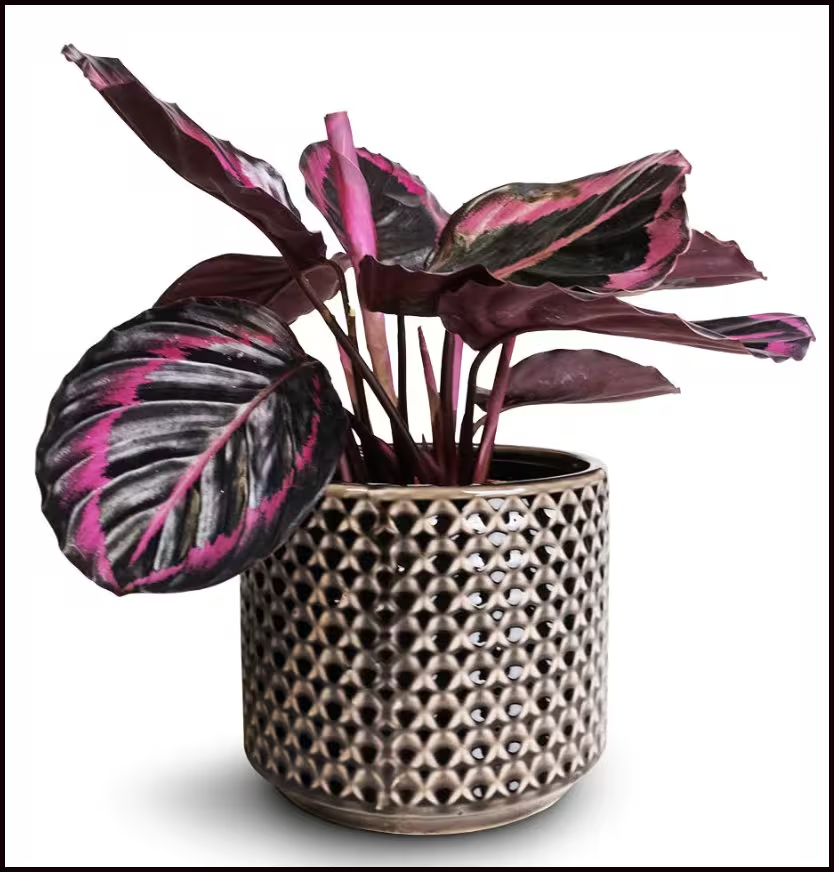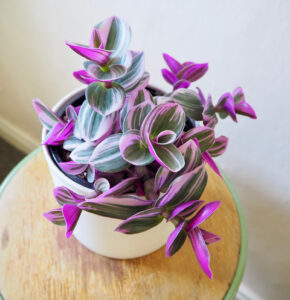The Rosy Calathea (Calathea roseopicta) is a stunning ornamental plant known for its striking, patterned foliage. As part of the Maranta family, Calathea plants are famous for their beautiful leaves that come in a variety of colors and patterns. The Rosy Calathea is particularly popular for its deep green leaves with pinkish or rosy markings, which gives it a unique and eye-catching appearance. Its foliage has a velvety texture, and the plant exhibits a graceful, upright habit that makes it an excellent choice for adding a touch of elegance to indoor spaces.
Caring for a Rosy Calathea can be a bit more challenging than some other houseplants, but with the right attention, it can thrive and reward you with its stunning display of colors. This care guide will walk you through everything you need to know about growing and maintaining a healthy Rosy Calathea.
1. Introduction to Rosy Calathea
- Scientific Name: Calathea roseopicta
- Common Name: Rosy Calathea, Rose-painted Calathea
- Family: Marantaceae
- Native Habitat: Native to the tropical regions of South America, specifically Brazil
- Size: Typically grows 12–18 inches tall and 12–18 inches wide
- Leaf Color: Green with pink or rose-colored markings on the upper surface, and purple or reddish undersides
- Flower Color: While Rosy Calathea can flower in ideal conditions, its blooms are not its main attraction. The flowers are small, white, and somewhat inconspicuous.
2. Choosing the Right Location
Rosy Calathea is best grown indoors, where it can receive the care and attention it needs to flourish. When selecting a location, keep the following in mind:
- Light Requirements: This plant thrives in bright, indirect light. Too much direct sunlight can scorch its delicate leaves, while insufficient light can lead to dull colors and poor growth. Ideally, place it near a window with filtered sunlight, such as in a room with sheer curtains. It can tolerate low light, but it will grow slower and may lose its vibrant markings.
- Temperature: Rosy Calathea prefers warm environments, ideally between 65–80°F (18–27°C). Avoid exposing it to temperatures below 50°F (10°C), as cold drafts or sudden temperature drops can stress the plant.
- Humidity: As a tropical plant, Rosy Calathea thrives in high humidity. It does best with humidity levels between 60% and 80%. In dry climates or during the winter when indoor air can be dry, you may need to increase humidity.
3. Soil Requirements
Rosy Calathea prefers well-draining, slightly acidic soil. Here’s how to choose the best soil for your plant:
- Soil Type: A rich, loamy, and slightly acidic potting mix is ideal. You can use a general houseplant mix and add perlite or sand to improve drainage.
- pH Level: Rosy Calathea prefers slightly acidic to neutral soil with a pH of around 6.0–7.0.
4. Watering the Rosy Calathea
Watering is one of the most important aspects of caring for Rosy Calathea. The plant requires consistent moisture but does not tolerate waterlogged soil, which can lead to root rot. Here are some key tips for watering:
- Watering Frequency: Water when the top 1–2 inches of soil feel dry. In warmer months, this may mean watering once a week, while in cooler months, you may need to water less frequently.
- Watering Method: Use room-temperature water, and ensure that the water drains freely from the bottom of the pot. Avoid letting the plant sit in water, as this can cause root rot. It’s best to water thoroughly but ensure excess water can drain away.
- Water Quality: Rosy Calathea is sensitive to chemicals in tap water, such as fluoride and chlorine, which can cause leaf browning and tip damage. If possible, use distilled or filtered water, or let tap water sit for 24 hours to allow these chemicals to dissipate before using it on the plant.
5. Fertilizing the Rosy Calathea
To encourage healthy growth and vibrant foliage, Rosy Calathea benefits from regular feeding, but it doesn’t require heavy fertilization.
- Fertilization Schedule: During the growing season (spring and summer), feed the plant once every 4–6 weeks with a balanced, water-soluble fertilizer. In fall and winter, when the plant is not actively growing, reduce or stop fertilizing altogether.
- Fertilizer Type: Use a balanced, diluted fertilizer (e.g., 10-10-10) or a specialized houseplant fertilizer. It’s important not to over-fertilize, as this can lead to nutrient burn or poor growth. Always dilute the fertilizer to half the recommended strength.
6. Pruning and Maintenance
While Rosy Calathea is not a high-maintenance plant, occasional pruning and maintenance will help keep it looking neat and healthy:
- Removing Dead Leaves: Over time, older leaves may yellow or die off. Use clean, sharp scissors or pruning shears to trim these leaves at the base, making sure not to damage healthy stems or leaves.
- Cleaning the Leaves: Dust can accumulate on the leaves, reducing their ability to photosynthesize and detracting from the plant’s appearance. Gently wipe the leaves with a soft, damp cloth to keep them clean. You can also occasionally mist the plant’s foliage to provide humidity and clean the leaves.
- Re-potting: Rosy Calathea grows fairly slowly, but every 1–2 years, it may need to be re-potted into a slightly larger container to allow for root expansion. The best time to re-pot is during the spring, as the plant is entering its active growing season.
7. Pests and Diseases
While Rosy Calathea is relatively resistant to pests, it can occasionally face some common issues, especially when stressed by improper care conditions:
- Common Pests:
- Spider Mites: These tiny, often invisible pests can cause speckled damage on the leaves. To control spider mites, regularly mist the plant with water, and wipe the leaves with a damp cloth. In severe infestations, insecticidal soap can be used.
- Mealybugs: These pests appear as small, cotton-like clumps on the plant. They can be controlled by wiping them off with a cotton swab dipped in rubbing alcohol.
- Scale Insects: These are small, hard, brown lumps that stick to the plant. They can be removed with rubbing alcohol or insecticidal soap.
- Diseases:
- Root Rot: Overwatering or poor drainage can lead to root rot. Ensure that the plant has good drainage and avoid letting the plant sit in standing water.
- Leaf Spot Disease: This fungal disease can cause brown or black spots on the leaves. It is usually the result of overwatering or watering from above. To prevent it, avoid overhead watering and improve air circulation around the plant.
8. Humidity and Temperature Control
Since Rosy Calathea is a tropical plant, it thrives in high humidity. Here are a few tips for ensuring your plant’s humidity needs are met:
- Misting: Mist the plant’s leaves regularly, especially during dry months, to increase humidity. However, be sure not to overdo it, as excessive moisture on the leaves can lead to fungal issues.
- Humidity Tray: Place a shallow tray filled with water and pebbles under the plant to help raise humidity levels around it. As the water evaporates, it will create a more humid microenvironment.
- Humidifier: If your indoor environment is particularly dry, especially during winter, consider using a humidifier to maintain the necessary moisture levels for your Rosy Calathea.
9. Winter Care
During the winter months, Rosy Calathea may enter a period of dormancy. Here’s how to care for it during the colder months:
- Reduce Watering: Since the plant will not be actively growing in the winter, reduce watering, but ensure the soil does not dry out completely.
- Maintain Humidity: As indoor air tends to be drier in winter, maintain a humid environment around the plant by misting, using a humidity tray, or employing a humidifier.
- Limit Fertilizing: Reduce or stop fertilizing during the winter months when the plant is not actively growing. This prevents over-fertilization, which can stress the plant.
10. Propagation
Rosy Calathea can be propagated by division. The best time to propagate is during spring or early summer when the plant is actively growing. Here’s how to propagate:
- Dividing the Plant: Carefully remove the plant from its pot, and divide the root ball into sections. Each section should have a portion of the root system and at least one healthy stem with leaves. Re-pot each section into its own container with fresh, well-draining soil.
- Caring for Divided Plants: After division, water the plants well and keep them in a warm, humid environment. They will establish roots and begin growing in a few weeks.
11. Common Problems and Solutions
- Yellowing Leaves: If the leaves of your Rosy Calathea are turning yellow, it could be a sign of overwatering, low humidity, or a nutrient deficiency. Adjust watering practices, ensure proper drainage, and increase humidity if needed.
- Brown Leaf Tips: This is often a sign of low humidity or inconsistent watering. Ensure the plant is watered regularly and mist the leaves or use a humidity tray to boost humidity.
- Leaves Curling or Wilting: If the leaves are curling or wilting, it may be due to underwatering, excessive heat, or a sudden temperature change. Make sure the plant is kept in a warm environment with consistent moisture.
12. Conclusion
The Rosy Calathea is a gorgeous and rewarding plant for those who are willing to provide the right conditions, including high humidity, proper watering, and bright, indirect light. With its stunning foliage and striking pink patterns, it’s sure to be an eye-catching addition to any home. By following the care guidelines in this guide, you can ensure that your Rosy Calathea thrives and remains a beautiful feature in your indoor garden.


